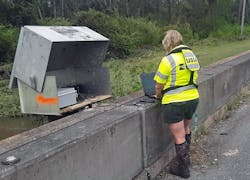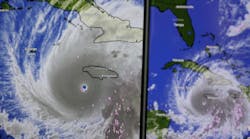USGS Measuring Record Flooding Caused By Hurricane Sally
More than 45 US Geological Survey scientists are in the field from Louisiana to Georgia, working to measure the extensive flooding across the Southeast caused by Hurricane Sally’s heavy rains. Some early estimates indicate Sally dumped as much as 20 inches of rain in areas between Mobile Bay in Alabama and Pensacola, FL.
USGS field crews are also repairing several USGS streamgage damaged by Sally, which is vital to ensuring the data USGS streamgage provide on river levels and flow continues to reach emergency managers, flood forecasters, and anyone threatened by potentially catastrophic flooding caused by Hurricane Sally.
During and after a storm, USGS streamgage information can be used by the National Weather Service to track floodwaters in real-time as they develop flood forecasts that are used to protect lives and property. The US Army Corps of Engineers also use USGS data to manage flood control at dams and reservoirs across affected regions.
Once a storm has passed, emergency managers can use USGS data to decide where to locate relief centers, so that aid can reach the most severely affected communities quickly.
In the coming weeks, USGS flood information can help the Federal Emergency Management Agency tell the difference between wind and water damage—important information for property owners and insurers. Over the long term, it can help emergency managers plan for future floods, improve computer models used by the National Weather Service to forecast flooding, and provide information used by FEMA to update the nationwide flood zone maps that underpin the federal flood insurance program.
In Alabama, where Sally made landfall as a Category 2 hurricane September 16, major flooding is underway with D'Olive and Tiawasee Creeks near Bridgehead setting preliminary peak of records; instances when river and streamgage recorded the highest levels ever measured at those locations. Crews are working to measure these sites to validate the readings to confirm they are new records.
“We have a few USGS streamgage east of Mobile, AL, that aren’t reporting back to us, so our crews will be fixing those streamgage as soon as possible,” said Vic Stricklin, Supervisory Hydrologist at the USGS Lower-Mississippi Gulf Water Science Center.
In Florida, areas in the Panhandle are seeing major flooding and preliminary data indicates that at least two rivers and two creeks have set new peaks of records. These sites include Bruce Creek in Redbay, Wrights Creek in Bonifay, Shoal River in Mossy Head, and Alaqua River in Pleasant Ridge. One USGS streamgage in Florida malfunctioned and is being repaired.
Some rivers and creeks in Alabama and Florida are still rising so there’s a potential for more peaks of record to be set in the coming days.
USGS crews are also deployed in Georgia measuring high water flows and repairing streamgage. In some parts of Georgia, rainfall totals in excess of 5 inches have been recorded from then Tropical Depression Sally. With North Carolina and South Carolina currently under tornado watches and flash flood warnings, USGS crews in those states will wait until the storm passes to begin work in those areas.
“Our teams in Georgia are working quickly to capture the impacts of Sally and we should be able to start fieldwork in the Carolinas tomorrow once it is safe to do so,” said John Shelton, Supervisory Hydrologist at the USGS South Atlantic Water Science Center.
Because this streamgage data and post-storm floodwater information are vital to people making key decisions about public safety, USGS crews will be in the field over the coming days repairing or replacing damaged instruments and conducting streamflow measurements as needed to confirm streamgage data.
As soon as floodwaters start to recede, the next step for USGS specialists will be to collect high-water marks in flooded areas. Floodwaters carry seeds and dirt that can stick to buildings, bridges, and trees. When floodwaters recede, they leave behind a line of debris that indicates the highest point the flood reached. These high water marks are fragile and easily destroyed, so observing, recording, and surveying them is done as quickly as possible, and is labor-intensive.
For more than 125 years, the USGS has monitored flow in selected streams and rivers across the U.S. The information is routinely used for water supply and management, monitoring floods and droughts, bridge and road design, determination of flood risk, and many recreational activities.
Source: USGS


